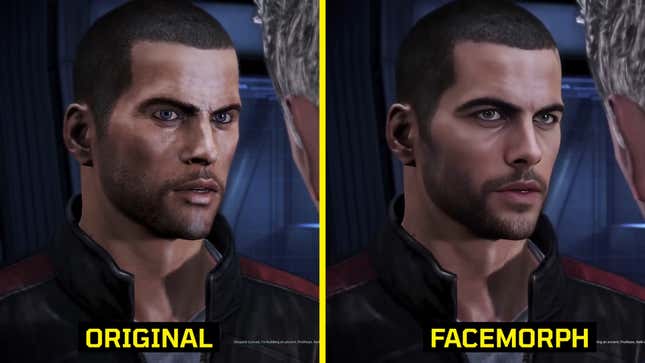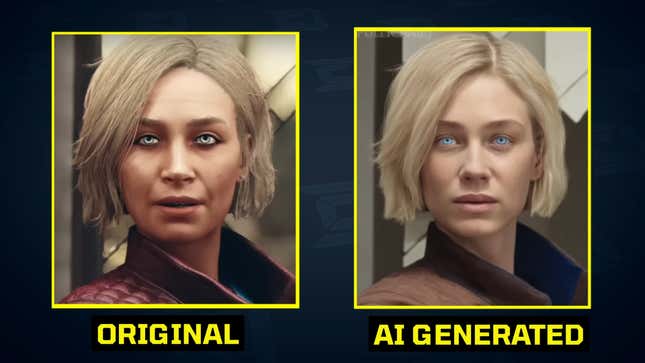Remember Corridor Digital, the Los Angeles-based production studio that made waves a few months back with its AI-generated “Rock Paper Scissors” anime video and the team’s claims that the tech could “democratize” the animation industry? That video wound up pissing off professionals who felt it was effectively just plagiarism, the AI having been trained on the work of actual, human animators. Well, they just released a new video that sets its sights on “fixing” video game faces, and it’s fathered its own hotbed of discourse.
On Wednesday, Corridor Digital uploaded a video titled “We Try Putting Photoreal Faces in Video Games.” In it, Corridor co-founder Niko Pueringer claims he and his team discovered that, by combining the AI face-morphing tech Insight Face with the popular AI image generator Stable Diffusion XL, they could “revolutionize how characters are rendered” by essentially grafting an AI-generated filter across a character model’s face so it looks more photo-realistic.
“Video games are notorious for having crude, mannequin-like human beings. If you’re playing a game, you just have to learn to ignore it or accept it if you want to enjoy the game. In fact, when a video game has human beings that are done well enough that you can emotionally connect with them, that’s considered an industry-wide achievement,” Pueringer said. “What we are going to show you is, in my opinion, the future of video game graphics. But right now, no one has done it yet. So come along as we combine the world of visual effects and video games to show you what the future might look like.”
What follows is a 17-minute video where the Corridor crew sits around on a couch and admires the AI “glow ups” they’ve given to characters like Nathan Drake from Uncharted, Aloy from Horizon: Forbidden West, and Big Boss from Metal Gear Solid, as smoothed-out, face-morphed images of their visages are compared to how they actually look in their respective games. They then proceed to recoil in laughter at how uncanny and emotionless some of their own creations look in motion. Well, Pueringer did claim their tech would evoke a strong emotional connection with players at the beginning of the video. I suppose full-bellied laughter would fit under that description. Like a cat bringing a dead rodent to its owner’s feet, allow us to present a selection of Corridor Digital’s face-morphed video game characters.
Commander Shepard from Mass Effect

Sarah Morgan from Starfield

Cloud Strife from Final Fantasy VII Remake

Read More: That ‘AI-Generated’ Anime Is A Slap In The Face To Pro Animators
Right off the bat, Corridor Digital’s suggestion that games with hyper-realistic-looking characters are more likely to elicit a strong emotional connection with players is wildly false. Elster from the 2022 survival horror game Signalis, for instance, is hardly rendered in extreme detail, but she nonetheless prompted one of the strongest emotional connections I’ve had with a video game character in recent memory as I assisted her in her harrowing mission. If anything, my desire to achieve a happy ending for her (despite hating horror games) was, in part, a result of how wonderfully expressive her low-poly character model manages to be. It’s a childish argument on Corridor Digital’s part to suggest that video game characters are automatically regarded as compelling to players if they possess more realistic facial expressions, or, by contrast, that they’re less compelling if they don’t.
Much like with Corridor Digital’s AI anime video, professionals and fellow YouTubers alike responded to argue that this video wildly misunderstands what makes the art form of video games so compelling to players in the first place.
“Great example of how well strong art direction and intentional design, modeling & texturing decisions hold up over time,” Apex Legends senior character artist Liz Edwards wrote on Twitter. “Thoughtless addition of detail for the sake of detail gives us cheap Halloween costume Snake.”
“I really need everyone at Corridor Digital to cut this out. Just go back to doing pretty good for YouTube compositing. I don’t need you guys to weigh in on either anime or gaming,” Chris Person, from the YouTube channel Highlight Reel, said. “I’m not joking this video sucks so bad, they’re just flabbergasted by the worst-looking stuff you’ve ever seen.”
“It felt like a fever dream tbh in one breath they’re laughing at bad lip-syncing an actual artist worked on and then losing their minds over a yassified video filter that completely changes the character and performance entirely.” 3D character artist George Crudo wrote.
Unlike with their “Rock Paper Scissors” video, the top comments on this one” aren’t going to bat for Corridor Digital’s efforts. Instead, commenters are asking the YouTube channel to go back to making pop culture-themed videos instead of more AI tech “experiments.”
To Corridor Digital’s credit, the crew acknowledges that the results of their glorified air-brushing experiment lack the humanistic expressions that the original digital artists who worked on these games painstakingly sculpted with aspects like the relationship between lighting and texturing in mind. There are some things a makeshift AI filter simply can’t account for. Hopefully, the YouTube channel will exercise more humility in the future by not pumping out another video evangelizing the supposedly revolutionary potential of AI to do artistic and creative things that humans are already pretty good at.






